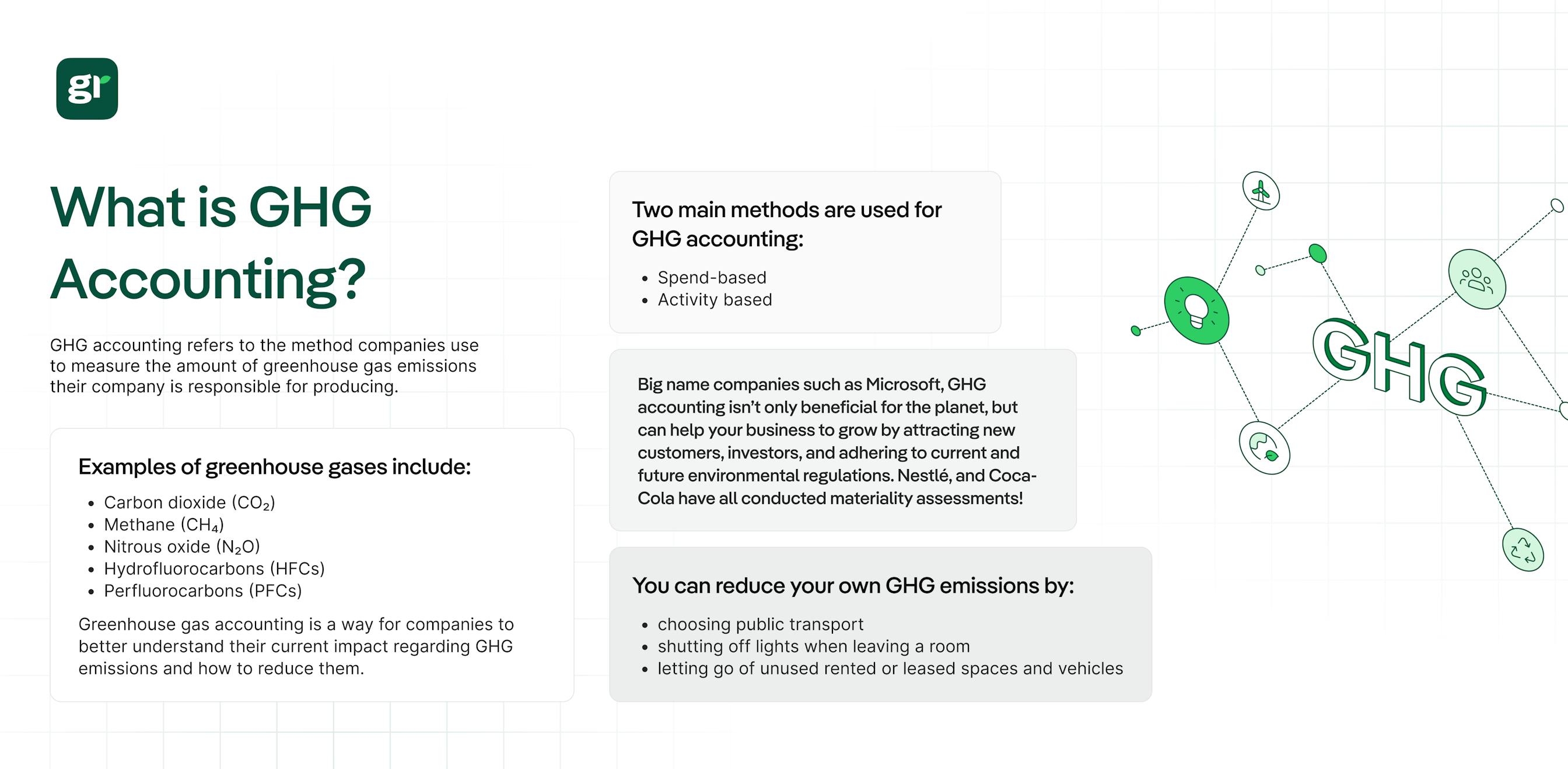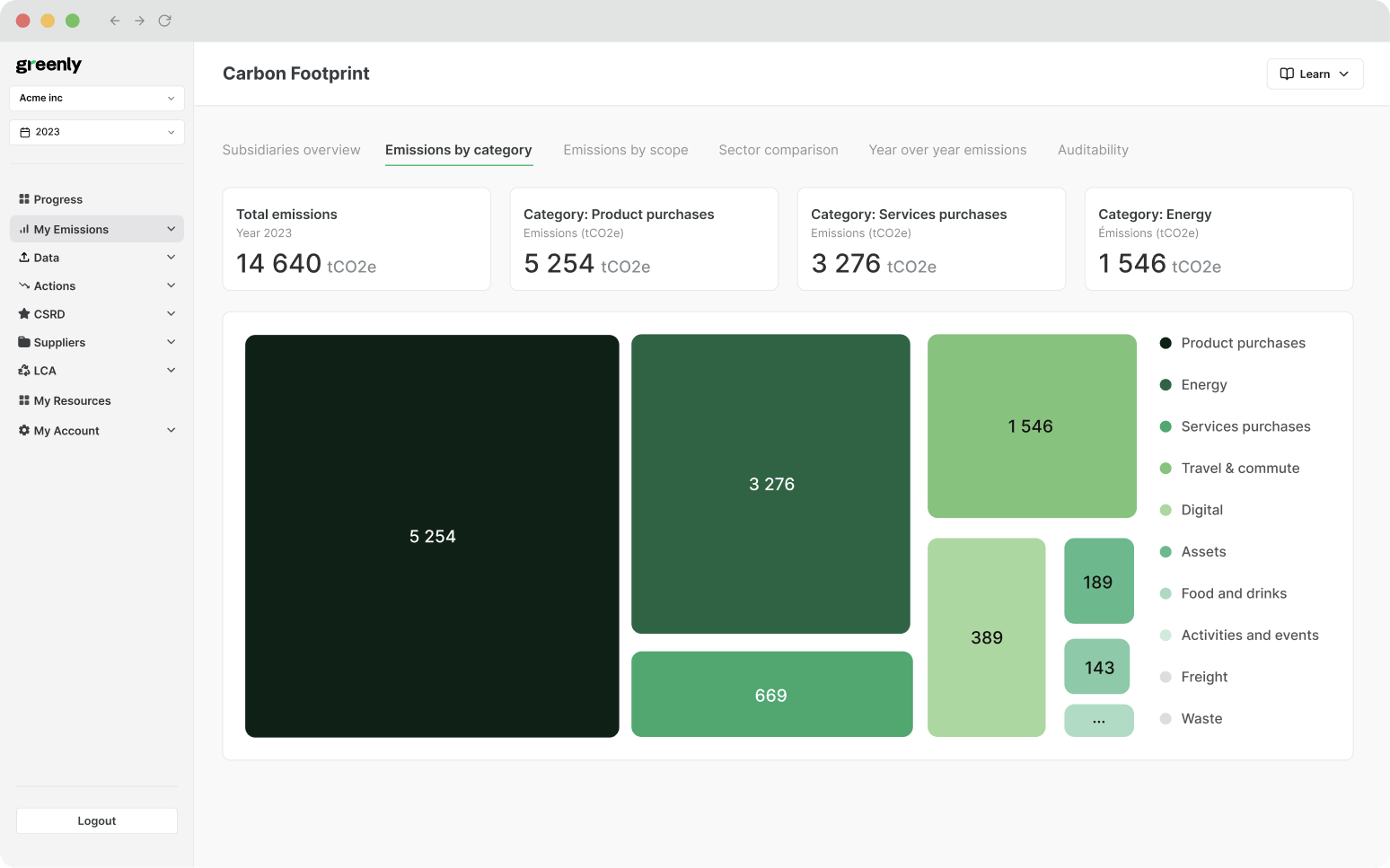
What are the 3 Pillars of Corporate Sustainability?
In this article, we'll explore what the 3 pillars of corporate responsibility are, why they're important, and how businesses can turn them into practical action.
ESG / CSR
Industries



As more companies commit to joining the movement towards net-zero emissions movement by 2050, an increasing number of businesses and organisations are seeking third party expertise to help them effectively measure and manage their carbon dioxide and greenhouse gas emissions. Most companies, while motivated to aid in the fight against climate change – face challenges identifying practical starting points when it comes to reducing their own carbon emissions.
According to peer-reviewed research, 100 energy companies are responsible for up to 71% of all industrial emissions – making it more important than ever before for companies to accurately assess and address their environmental impact.
As a result, organisations increasingly partner with third-party companies that offer greenhouse gas accounting services – but how do GHG accounting services help companies to reduce their carbon emissions and improve their efforts towards sustainability?
In this comprehensive guide, we'll explain the fundamental principles of GHG accounting, the different methodologies and standards used, and evidence-based strategies to reduce GHG emissions to mitigate global warming.


Greenhouse gas accounting is the way companies can measure how many overall emissions and greenhouse gases they are producing and emitting into the atmosphere.
Some of the main greenhouse gases include:
These greenhouse gases trap heat in the atmosphere and contribute to global warming and overall temperature rise as a result of human activity. According to the comprehensive scientific assessment in the sixth assessment report by the IPCC, these concerning temperatures will continue to rise unless significant, coordinated action is taken to reduce emissions.
In 2022, greenhouse gas emissions in the U.S. reached a massive 6,343 million metric tons of carbon dioxide equivalents. This significant increase in carbon dioxide emissions has occurred since the industrial revolution began as a result of an increase in fossil fuel combustion, efforts to generate electricity and grow the energy sector, land use changes, and overall human activities.
Here's a table depicting the increase in GHG emissions over the last 30 years:
| Sector | Change in GHG Emissions (2022 vs 1990) |
|---|---|
| Power Industry | +92% |
| Industrial Combustion and Processes | +95% |
| Buildings | 0% |
| Transport | +72% |
| Fuel Exploitation | +56% |
| Agriculture | +21% |
| Waste | +58% |
| All sectors | +62% |
Greenhouse gas (GHG) accounting is often referred to as carbon accounting.
Ultimately, greenhouse gas accounting serves as the most surefire, globally accredited way to measure a company's direct GHG emissions and carbon dioxide equivalents so that their efforts to reduce their own emissions can be accurately depicted to others in the carbon market.
The main goal of corporate GHG accounting, or carbon accounting, is to provide the amount of greenhouse gas or carbon dioxide emissions produced with a set value so that they can be fairly traded in the carbon market.
As global temperatures and levels of greenhouse gas concentrations continue to skyrocket, more companies have become aware of the negative impact of their use of fossil fuels and how a large carbon footprint could be troublesome for their future business endeavors.
In fact, as of 2016, a whopping 92% of Fortune 500 companies (or companies part of the list of the largest 500 companies ranked by revenue in the U.S.) made using the Carbon Disclosure Project (CDP), GHG Protocol, or a third-party program which follows the values depicted in the GHG Protocol to monitor and manage their greenhouse gas emissions.
The Greenhouse Gas Protocol provides the comprehensive framework organisations use to report GHG emissions. This standardised approach helps companies submit accurate data to initiatives such as the Carbon Disclosure Project. Through robust greenhouse gas accounting, companies develop greater transparency with their investors, employees and customers by providing verifiable numerical data for which they can be held accountable.

Greenhouse gas accounting is the process of measuring the amount of greenhouse gas emissions a company is producing, whereas carbon assessment is the process of evaluating the data provided by greenhouse gas accounting.
In short, GHG accounting is nothing more than a number. It’s like learning about how to make sense of your credit score: it’s nothing more than a number until you understand if the number is associated with a good or bad credit score.
For some people, a bad credit score will not motivate them to alter their spending habits – but for others, it will be a wake up call for them to make better credit decisions and be more mindful of how they spend their money going forward.
On the other hand, the number delineated one’s credit score may not influence their financial habits at all, and won’t influence their financial decisions in the future.
The World Business Council for Sustainable Development emphasises that GHG accounting provides quantitative data that organisations must interpret effectively. Similar to understanding a financial metric, such as your credit score, the emissions figure alone has limited value until analyzed within the context of climate-related risks and organisational performance.
A carbon assessment takes the incentive of greenhouse gas accounting one step further, as it evaluates the data from greenhouse gas accounting to help the individual or company responsible for emissions to create new habits that can reduce emissions and climate related risks.
In addition to comprehensive greenhouse gas accounting services that align with international standards, Greenly can offer our clients a detailed carbon assessment to help them on their journey to becoming more environmentally friendly, adhere to climate related financial disclosures, and meet their sustainable development goals.
Here are the different different methods of greenhouse gas accounting broken down:
The first approach to GHG accounting is the spend-based method. The spend based method works by multiplying the financial value of something a company purchases by the amount of carbon dioxide or greenhouse gas emissions it emits to produce a numerical piece of data.
The spend based method of GHG accounting is often considered the easier approach, as it requires less time to calculate. However, this method of GHG accounting lacks precision as prices are subject to change on a constant basis, especially during periods of inflation.
According to carbon accounting experts, the spend-based method of GHG accounting is appropriate for preliminary assessments and quick calculations, but it isn't the most accurate way to measure a company's comprehensive carbon footprint.
The second method to greenhouse gas accounting is the activity-based method. The activity based method, which is more specific than the spend-based method, uses data to retrieve how many units of specific materials have been purchased.
Research indicates that both the spend-based method and the activity-based method utilise emission factors derived from lifecycle assessment studies to determine a company's impact on overall emissions.
However, it is important to note that while the activity based approach to carbon accounting is more reliable than spend-based method, it is still recommended that companies implement a hybrid model or combined methodology when committing to greenhouse gas accounting. In other words, companies should strive to use both the spend-based method and the activity based method simultaneously. Using both approaches to greenhouse gas accounting can help companies determine their carbon footprint with greater accuracy and completeness.
The battle cards below will break down the differences between the Spend-Based Method and the Activity-Based Method:

Greenhouse gas accounting is important as it can help a company improve in all areas of business, such as by reducing their total emissions or by adhering to GHG accounting standards or other environmental regulations – all of which can make a business more attractive to customers and investors.
For instance, greenhouse gas accounting is a step towards developing corporate sustainability. Potential investors and customers are becoming more interested in investing or purchasing products and services from businesses that implement environmental habits that seek to mitigate climate change, such as by implementing the use of renewable energy or implementing energy efficiency protocols.
According to the World Resources Institute, the concrete data provided by standardised GHG accounting helps to establish transparency and prevent allegations of greenwashing. This is because the statistics provided by greenhouse gas accounting serve as tangible, numerical proof that your company is making a verifiable effort to reduce their emissions.
Here are a few more reasons why GHG accounting is important:
Beyond reducing emissions, it's important to note that comprehensive GHG accounting enables organisations to enhance overall environmental quality through improved land management practices and more efficient wastewater treatment systems. By implementing robust corporate standards for environmental performance, companies can track progress toward their Paris Agreement-aligned commitments with greater precision and accountability.
All in all, research demonstrates that comprehensive greenhouse gas accounting delivers multitude of benefits across business operations. In other words, when companies commit to improving sustainability and reducing their emissions through rigorous GHG accounting – they create opportunities for stronger relationships with value chain partners, investors, customers, and employees who will want to take part in the project.
The Science Based Targets Initiative has documented how this integrated approach creates a positive feedback loop for continued financial and environmental success.

The categories of greenhouse gas accounting are referred to as, “scopes” – these scopes in GHG accounting aim to make calculating carbon emissions easier.
Scope 1 emissions, scientifically classified as direct emissions, result from environmental impacts caused by industrialisation or vehicles used within a company. Any use of fossil fuels or non-renewable energy would fall under this category of greenhouse gas accounting.
Scope 2 emissions, officially categorised as indirect emissions, encompass any energy required to power something within the company, such as purchased electricity, rented or leased office spaces, cars, central heating or air conditioning.
Scope 3 emissions, or comprehensively defined as value chain emissions, include any other miscellaneous activities that don’t qualify for scopes one or two. Carbon emitting activities that could fall under scope three could include the use of raw materials, buying various goods or services, the carbon footprint of employees who commute to work, or even business travel from a flight.
According to the Greenhouse Gas Protocol, Scope 3 emissions typically represent the largest portion of an organisation's carbon inventory. These emissions occur outside of the company itself, but the company is still an indirect cause of these emissions. For instance, the company cannot control how many emissions a flight produces – but sending an employee on a business trip means the company is still contributing to the carbon footprint inducing activity.
Therefore, research confirms that scope 3 emissions are known to be the most difficult category in greenhouse gas accounting to measure and require specialised methodologies for accurate quantification.
Choosing the right GHG (greenhouse gas) accounting tool is key to accurately tracking your emissions and aligning with climate targets – especially as this is becoming a key step for large companies and other entities to demonstrate their commitment to greater sustainability.
In 2025, several reputable platforms are available to help companies meet their carbon reporting and reduction goals, including:
It's important to remember that when choosing a greenhouse gas accounting software, tool, or resources to ensure that the platform of your choice can help your company to achieve its specific climate change goals.
When selecting a GHG accounting platform, ensure it offers:
Explore our in-depth guide to the best carbon accounting tools here.
Yes – greenhouse gas (GHG) accounting plays a crucial role in identifying and mitigating emissions, making it a foundational step in any credible climate strategy. However, while GHG accounting itself does not reduce emissions, it equips organisations and individuals with data-driven insights needed to take meaningful climate action. This can include inspiring a company to implement new, healthier environmental measures.
Greenhouse gas accounting can provide one with the data necessary to evaluate which areas can be improved upon, but it is ultimately up to the individual or company to establish those new carbon emissions reducing measures – and then work hard to sustain them.
By accurately measuring emissions across scopes 1, 2, and 3, companies can pinpoint high-impact areas in their operations and supply chains. This enables decision-makers to implement targeted strategies, such as adopting energy-efficient technologies, transitioning to renewable energy, or optimising logistics, to reduce their carbon dioxide equivalent (CO₂e) footprint.
GHG accounting is most effective when paired with actionable plans, such as:
Overall, GHG accounting is not the end goal – but a guide that can help companies to effectively employ improved sustainability and emission reduction strategies. When leveraged effectively, GHG accounting can help to support long-term climate resilience and contributes to the global effort to limit warming to 1.5°C.
Greenhouse gas accounting isn’t the only way a company can reduce their emissions. While it’s best to hire third-party assistance for optimal results in classifying and reducing a company’s emissions – it doesn’t mean a company can’t do anything about their emissions if they can’t afford to hire someone to do their greenhouse gas accounting for them.
Research shows that rising global temperatures are encouraging several countries worldwide to re-evaluate their approach to GHG emissions management and recognise the value in exceeding basic reporting requirements to meaningfully reduce their climate impact.
Here are 3 small steps your company can take to begin reducing their emissions
Whenever no one is in the office, ensure that all heating, air conditioning, lights, and devices are turned off when not in use to prevent using electricity when it’s not necessary.
According to energy efficiency experts, implementing this practice will not only reduce your organisation's carbon footprint – but also results in measurable cost savings through lower electricity bills. These financial resources can then be reallocated to fund other environmental initiatives within the company.
If your company still hasn’t switched to remote status, it would be extremely effective to offer your employees with public metro passes, ride share service discounts, or a subscription to a shared bike or scooter service.
Environmental transportation studies, such as from the SBTi, indicate that this approach serves as an effective strategy for companies to significantly reduce their Scope 3 emissions related to employee commuting, which often represent a substantial portion of an organisation's overall carbon footprint.

Do you have leased office spaces or vehicles that aren’t being used as much as they were before?
Optimising your organisation's physical footprint can deliver substantial environmental benefits. By canceling the lease of underutilised office spaces or vehicles, your company won't only achieve cost savings – but will significantly reduce energy consumption and associated greenhouse gas emissions by eliminating the resources needed to power, heat, cool, and maintain these assets.
Property management research indicates this strategy can effectively decrease both Scope 1 and Scope 2 emissions, particularly in organisations with multiple locations or distributed operations.
office spaces or cars, your company won’t only save money – but will be exerting less energy and greenhouse gas emissions by not using electricity to power or maintain these leases, and ultimately reduce the level of greenhouse gas emissions your company is emitting.
Greenly places a high emphasis on precise scope emissions data collection and analysis to ensure the most accurate information to present clients with a robust decarbonization strategy. In addition to our focus and precision on difficult-to-measure scope 3 emissions, we also offer indispensable assistance with CSRD, SBTi, ISO, and other environmental regulations or applications to help organizations demonstrate greater sustainability.
Yes, Greenly seeks to prioritise tracking scope 1, 2, and 3 emissions when helping companies determine their current carbon footprint — providing a foundation for effective reduction strategies later on.
We successfully provide users with scope-based reporting software by using both the spend-based and activity-based methods for calculating emissions across all three scopes.
We provide extensive scope 3 management, LCA impact assessments, materiality assessments for CSRD compliance, audit-ready reports, and robust data analytics — all supported by our team of climate experts to ensure effective GHG emissions reporting.
Greenly is a top-tier carbon accounting platform known for its user-friendly dashboards, automated data collection, and end-to-end sustainability tools. As an all-in-one solution, Greenly supports companies through complex environmental regulations like CSRD and SBTi, while also offering features such as LCA impact assessments, supplier engagement, and carbon offset tracking. Its scalable design and personalised guidance make it a trusted partner for businesses of all sizes committed to climate leadership.
If reading this article about GHG accounting, how it works, and why its important has made you interested in reducing your carbon emissions to further fight against climate change – Greenly can help you!
Figuring out how to manage GHG accounting on your own to help fight against climate change and reduce your emissions can be stressful.
Here’s how Greenly can support your business:
At Greenly we can help you to assess your company’s carbon footprint, and then give you the tools you need to cut down on emissions. We offer a free demo for you to better understand our platform and all that it has to offer – including assistance with boosting supplier engagement, personalised assistance, and new ways to involve your employees.
Click here to learn more about Greenly and how we can help you reduce your carbon footprint.
Greenly places a high emphasis on precise scope emissions data collection and analysis to ensure the most accurate information to present clients with a robust decarbonization strategy. In addition to our focus and precision on difficult-to-measure scope 3 emissions, we also offer indispensable assistance with CSRD, SBTi, ISO, and other environmental regulations or applications to help organizations demonstrate greater sustainability.
Yes, Greenly seeks to prioritize tracking scope 1, 2, and 3 emissions when helping companies determine their current carbon footprint — providing a foundation for effective reduction strategies later on.
We successfully provide users with scope-based reporting software by using both the spend-based and activity-based methods for calculating emissions across all three scopes.
We provide extensive scope 3 management, LCA impact assessments, materiality assessments for CSRD compliance, audit-ready reports, and robust data analytics — all supported by our team of climate experts to ensure effective GHG emissions reporting.
Greenly is a top-tier carbon accounting platform known for its user-friendly dashboards, automated data collection, and end-to-end sustainability tools. As an all-in-one solution, Greenly supports companies through complex environmental regulations like CSRD and SBTi, while also offering features such as LCA impact assessments, supplier engagement, and carbon offset tracking. Its scalable design and personalized guidance make it a trusted partner for businesses of all sizes committed to climate leadership.
